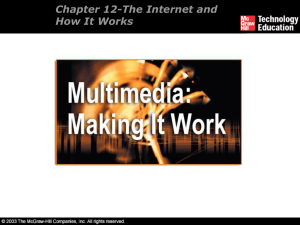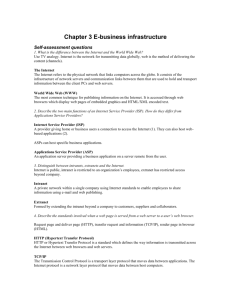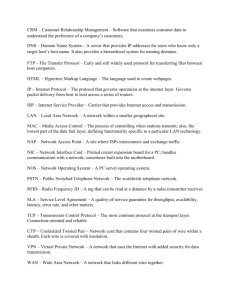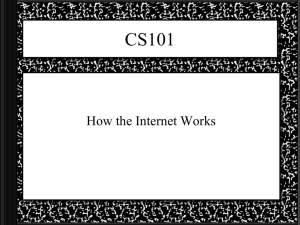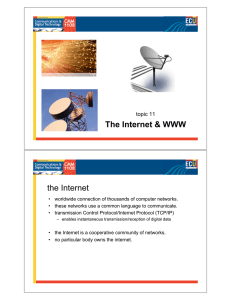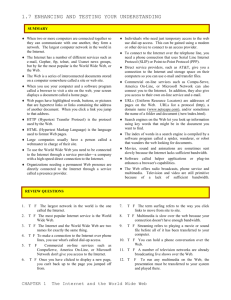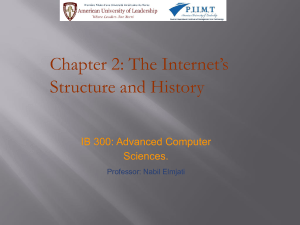COM 205 Multimedia Applications St. Joseph’s College Fall 2004
advertisement
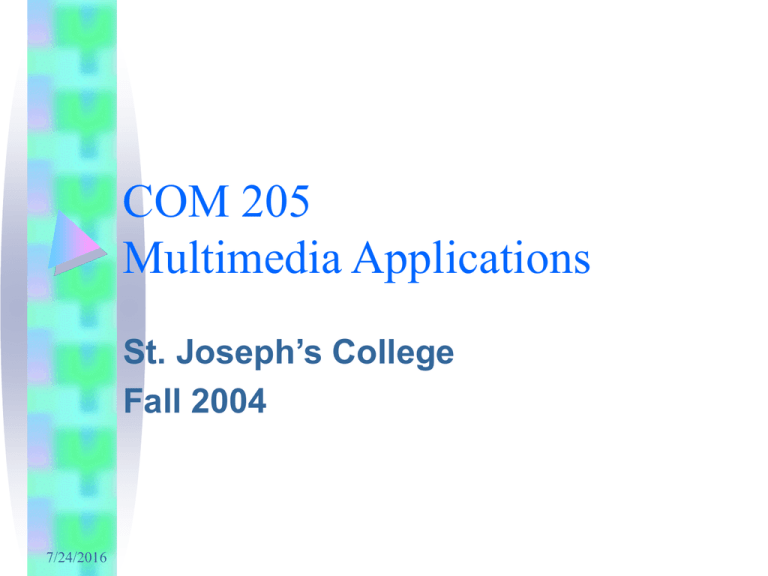
COM 205 Multimedia Applications St. Joseph’s College Fall 2004 7/24/2016 Chapter 12 The Internet and How It Works 7/24/2016 HISTORY A. ARPANET • 1. The Internet was created in 1969 by the Advanced Research Projects Agency (ARPA). – a)ARPA was part of the U.S. Department of Defense. – b) The ARPANET grew as it networked universities, military sites, and government agencies. • 2. In 1985, National Science Foundation (NSF) used ARPANET to connect supercomputers and computer science centers. – a)Management of the ARPANET officially passed to the NSF in 1989. • 3. Commercial use of the Internet began in 1992. Internetworking Networking basics • 1. Two or more computers connected to each other make a network. • 2. A local network is called a local area network (LAN). • 3. Distant LANs can be connected via phone lines or another medium to form a wide area network (WAN). • 4. LANs, WANs, and individual computers can also connect to the Internet through a server. a)A server is permanently connected to the Internet through a high-bandwidth physical connection Internetworking • TCP/IP is the protocol used for communicating on the Internet – TCP is Transmission Control Protocol – IP is the Internet Protocol • In 1983 the Domain Name System (DNS) was established to assign names to computers which were linked to the Internet. Internet Addresses • 1. Address syntax • a) Internet addresses use the following syntax: [protocol]://[domain name]/[path]/[file name] ( http://www.sjcny.edu) for example • b) The server directory path and file name are often left off. • c) The protocol usually does not need to be typed. • d) The protocol is also often hidden, such as • (1) mailto • (2) news Internet Addresses • 2. Top-level domains (TLDs) – a) The current Domain Name System (DNS) was developed in 1983. – b) TLDs were established for various categories. – c) The TLD is part of the domain name, such as • (1) .com • (2) .net • (3) .gov • (4) .mil • (5) • (6) . edu Two-letter country codes Domain Name System ( DNS) • In 1998 (ICANN) Internet Corporation for Assigned Names and Numbers was set up to oversee the DNS. • In 2000, ICANN approved seven new TLDs: • aero info pro • biz museum • coop name Domain Name System ( DNS) • Other names are under discussion and may be added in the future: • web • arts • shop • firm • nom • rec IP Addresses and Data Packets • A The Internet transmits data using the Transmission Control Protocol (TCP). • (1) Data is broken up into packets. • B The Internet Protocol (IP) transmits the packets. • (1) Packets can travel along various paths and are reassembled at the receiving end. • (2) Destinations are identified by numeric IP addresses such as: 140.174.162.10 • (3) Domain name servers look up these addresses. Connections • 1. To connect to the Internet, a computer or network needs – a) A data connection to a server • (1) The data connection can be wireless or a land line. • (2) You usually need an account with the server. • (3) Most people access a server through an Internet service provider (ISP). – b) TCP/IP software • (1) Your operating system may need to be configured to connect to the server and use TCP/IP software. Connections • c) Internet software includes – (1) E-mail programs – (2) Web browsers – (3) FTP software – (4) News readers • d) ISP ( Internet Service Providers) software – PPP - (Point to Point) for dialing up – TCP/IP for sending and receiving – POP (Point of Presence) - local telephone number Bandwidth Bottleneck • 1. Bandwidth is how much data, you can send from one computer to another in a given unit of time ( See p. 337) • 2. The bandwidth bottleneck – a) Bandwidth is measured in bits per second (bps). – b) Available bandwidth greatly affects how a person can use the Internet. – c) Users with slow connections will have a difficult time using multimedia over the Internet. Bandwidth Bottleneck • d) To accommodate low bandwidth users • (1) Compress data when possible. • (2) Take advantage of the browser’s cache. • (3) Design for download efficiency- don’t overdo animation, colors, etc. • (4) Design alternate sites for low- and high-bandwidth users. • (5) Consider using streaming technology. Internet Services • 1. Services include http, ftp, telnet, Usenet, SMTP, IRC, and others. – a)Some services, such as Gopher, are not commonly used. • 2. Multipurpose Internet Mail Extensions (MIME)-types – a)Files used online must conform to Internet protocols. – b)Data types are identified using MIME-types. – c) File types must be recognized by servers to be used on the Internet. The World Wide Web and HTML • A. Web history • 1. Tim Berners-Lee of CERN (the European Particle Physics Laboratory) developed the Web’s hypertext system in 1989. – a)The Hypertext Transfer Protocol (HTTP) was designed as a means for sharing documents over the Internet. – b)The Hypertext Markup Language (HTML) is the markup language of the Web. – c) Cross-platform compatibility was a design goal. HTTP • The Hypertext Transfer Protocol ( HTTP) provided rules for a simple transaction: • 1. Establishing a connection • 2. Requesting that a document be sent • 3. Sending a document • 4. Closing the connection HTML • The HTTP protocol also required a simple document format called HTML (Hypertext Markup Language) for presenting text and graphics • The HTML document can contain hotlinks which a user can click to jump to another location Dynamic Web pages and XML • 1. Advanced tools can be used to make a Web page dynamic. – a)Dynamic technologies include • (1) Cold Fusion (CFM) • (2) Hypertext Preprocessor (PHP) • (3) Active Server Pages (ASP) • (4) Java Script and Java Applets – b)Dynamic pages work in conjunction with database applications to look up data. (XML) eXtensible Markup Language – a) XML goes beyond HTML and is the next step in developing web pages. – b) This markup language allows developers to define their own styles and elements. – c) It allows you to create your own tags to describe what the data means – d) Whether or not XML is the future of Web design is still somewhat questionable. • Check www.xml.org and www.xml.com Multimedia on the WEB • Developers need to understand how to create and edit elements of multimedia and also how to deliver it for HTML browsers • The number of new users of the web will create a greater need for high quality, compelling content, and reasonably quick presentations Project Idea • • • • Visit these web sites http://www.navy.com/ http://www.sigov.si/ http://www.w3.org/MarkUp/Guide/Style. html – For each address, answer the following questions: – What is the title of the Web page? – Briefly describe the content of the Web page. – What is unique about the URL?
